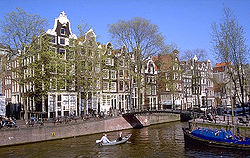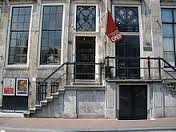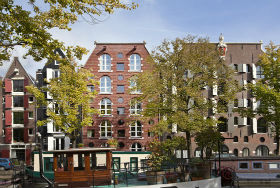 May, 2013 – Brisk Recorder Quartet played the première of my recent The Bridal Kiss at a number of concerts during the Promenade Concerts in the Amsterdam Biblical Museum, the Museum Van Loon and the Geelvinck Hinloopen House. The Amsterdam Biblical museum provided surroundings that were doubly appropriate.
May, 2013 – Brisk Recorder Quartet played the première of my recent The Bridal Kiss at a number of concerts during the Promenade Concerts in the Amsterdam Biblical Museum, the Museum Van Loon and the Geelvinck Hinloopen House. The Amsterdam Biblical museum provided surroundings that were doubly appropriate.

The canal ring area of Amsterdam is world famous.
Since its inception in 1613, its curved rings of parallel canals, lined by high rising merchant’s houses with their typical curved or stepped gables, formed the Amsterdam city harbour that would provide the Low Countries a platform for the wealth in its 17th century’s Golden Age. In 2010, the Unesco added the canal ring area to the World Heritage List.

As part of the 2013 celebration of the 400th anniversary of the Amsterdam Canal District, a Promenade concert was organized that allowed participant audiences to stroll around this area to visit three consecutive concerts in three Museums housed in historical dwellings: Bijbels Museum-Cromhouthuizen (at the famous Herengracht), the Museum van Loon (in a mansion of one of the founders of the East-India Company, at the Keizersgracht) and the Geelvinck Hinloopen House, a ‘city palace’ spanning the borders of Herengracht and Keizersgracht.

Brisk Recorder Quartet was one of three ensembles specialized in historical music (the others being Musica Amphion and Camerata Trajectina) that played programmes appropriate to their location. In Brisk’s case: the Bijbels Museum, or rather it’s recently aqcuired annex, the stunning ‘city palace’ of the wealthy 18th century merchant family Cromhouts. There, the large reception hall, now a concert venue, is decorated with numerous paintings on religious themes, varying from Biblical representations to paintings of Amsterdam church buildings.

An appropriate location indeed for a baptism of my The Bridal Kiss, music that captures part of a Jewish wedding ritual that must have been performed thousands of times in the city of Amsterdam (lovingly called ‘Mokum’ by its Jewish inhabitants), and that may well have been the subject of Rembrandt’s famous painting.
Brisk played the programme, featuring Telemann (published in Amsterdam) and Sweelinck, five times in a row to great satisfaction of the promenading audiences.
 I venture to compare my music a little to architect Sjoerd Soeters’ reconstruction of some of the houses on the Brouwersgracht – a new construction that celebrates old forms and techniques. From that view point, the surroundings were appropriate in a double sense.
I venture to compare my music a little to architect Sjoerd Soeters’ reconstruction of some of the houses on the Brouwersgracht – a new construction that celebrates old forms and techniques. From that view point, the surroundings were appropriate in a double sense.